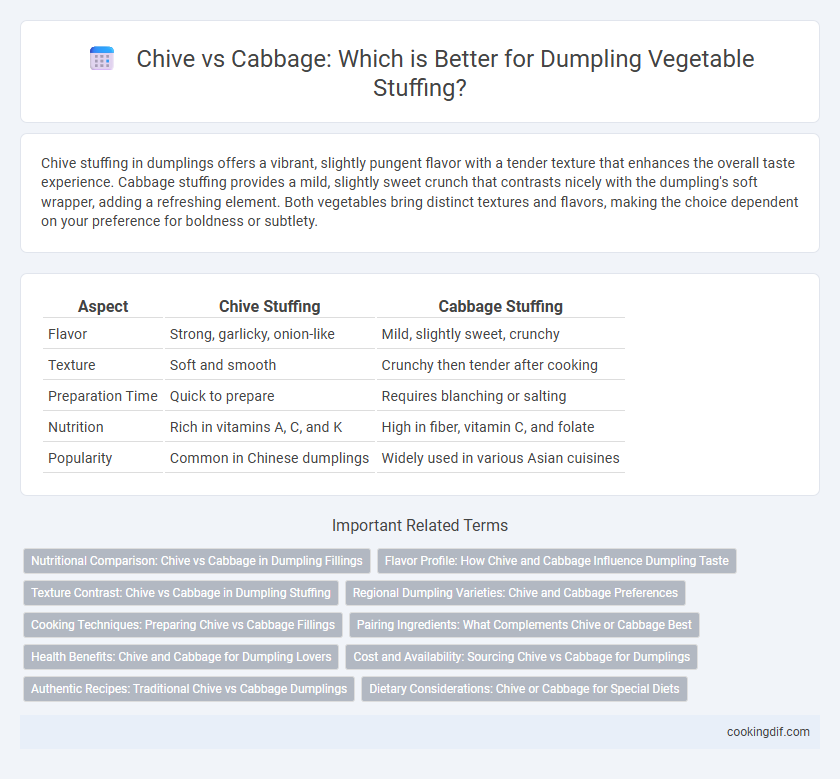Chive stuffing in dumplings offers a vibrant, slightly pungent flavor with a tender texture that enhances the overall taste experience. Cabbage stuffing provides a mild, slightly sweet crunch that contrasts nicely with the dumpling's soft wrapper, adding a refreshing element. Both vegetables bring distinct textures and flavors, making the choice dependent on your preference for boldness or subtlety.
Table of Comparison
| Aspect | Chive Stuffing | Cabbage Stuffing |
|---|---|---|
| Flavor | Strong, garlicky, onion-like | Mild, slightly sweet, crunchy |
| Texture | Soft and smooth | Crunchy then tender after cooking |
| Preparation Time | Quick to prepare | Requires blanching or salting |
| Nutrition | Rich in vitamins A, C, and K | High in fiber, vitamin C, and folate |
| Popularity | Common in Chinese dumplings | Widely used in various Asian cuisines |
Nutritional Comparison: Chive vs Cabbage in Dumpling Fillings
Chive stuffing in dumplings offers a rich source of vitamins A and C along with antioxidants that support immune health, whereas cabbage provides higher fiber content aiding digestion and contains glucosinolates linked to cancer prevention. Chives have a lower calorie count and offer a distinctive savory flavor enhanced by sulfur compounds, while cabbage delivers bulk and moisture, contributing to a balanced texture in dumpling fillings. Both vegetables add essential nutrients, but cabbage's superior fiber and chive's potent micronutrients make each beneficial depending on dietary goals.
Flavor Profile: How Chive and Cabbage Influence Dumpling Taste
Chive imparts a sharp, slightly garlicky flavor that enhances dumplings with a fresh and aromatic bite, while cabbage offers a mild, slightly sweet, and crunchy texture that balances richness and adds subtle earthiness. The pungent notes of chive create a vibrant contrast to savory fillings, making each bite more dynamic, whereas cabbage provides a softer, more neutral taste that complements a variety of spices and meats. Combining both can result in a complex umami profile, blending the zesty brightness of chive with the gentle sweetness of cabbage for a well-rounded dumpling experience.
Texture Contrast: Chive vs Cabbage in Dumpling Stuffing
Chive provides a tender yet slightly crisp texture that enhances the overall softness of dumpling stuffing, creating a subtle contrast with the dough's chewiness. Cabbage delivers a crunchier, juicier bite that introduces a pronounced textural variation, balancing the dumpling's pliable exterior. The choice between chive and cabbage significantly influences the mouthfeel, with chive offering a delicate texture and cabbage contributing volume and crunch.
Regional Dumpling Varieties: Chive and Cabbage Preferences
In regional dumpling varieties, chive and cabbage are preferred vegetable fillings reflecting local flavors and textures. Northern Chinese dumplings often feature cabbage stuffing for its mild sweetness and moisture content, enhancing the dumpling's juiciness. In contrast, southern regions favor chive fillings, prized for their pungent aroma and unique savory taste that complements pork or shrimp mixtures.
Cooking Techniques: Preparing Chive vs Cabbage Fillings
Chive fillings require finely chopping and blanching to soften their sharp flavor while preserving vibrant color, ensuring a balanced taste in dumplings. Cabbage stuffing benefits from thorough salting and squeezing to remove excess moisture, preventing sogginess and achieving a tender texture. Both vegetables demand precise preparation steps to maintain optimal texture and flavor during steaming or frying.
Pairing Ingredients: What Complements Chive or Cabbage Best
Chive stuffing in dumplings pairs exceptionally well with ground pork, garlic, ginger, and soy sauce, enhancing its fresh, mild onion flavor. Cabbage stuffing complements ingredients like shiitake mushrooms, scallions, ground pork or tofu, and sesame oil, bringing a crunchy texture and subtle sweetness. Both vegetables benefit from a touch of sesame oil and soy sauce to balance and deepen the overall taste profile.
Health Benefits: Chive and Cabbage for Dumpling Lovers
Chive stuffing in dumplings offers high levels of vitamins A and C, along with antioxidants that support immune health and improve digestion. Cabbage provides rich fiber content and glucosinolates, compounds linked to cancer prevention and reduced inflammation. Choosing between chive and cabbage enhances dumpling nutrition by incorporating either potent antioxidants or gut-friendly fiber.
Cost and Availability: Sourcing Chive vs Cabbage for Dumplings
Cabbage offers a cost-effective and widely available option for dumpling stuffing, especially in grocery stores and farmers' markets year-round, making it a budget-friendly choice for large batches. Chive, being a specialty herb, tends to be pricier and seasonal in certain regions, which can limit its availability and increase overall dumpling preparation costs. Sourcing cabbage supports consistent supply and affordability, while chive adds unique flavor but requires consideration of higher prices and limited market presence.
Authentic Recipes: Traditional Chive vs Cabbage Dumplings
Traditional chive dumplings feature a vibrant filling made from finely chopped Chinese chives, often combined with scrambled eggs and sometimes shrimp, delivering a bold and aromatic flavor that is prized in many authentic northern Chinese recipes. Cabbage dumplings, commonly found in northern and northeastern Chinese cuisines, use finely shredded Napa cabbage mixed with ground pork or mushrooms, offering a milder, slightly sweet taste and a tender texture that complements the dough perfectly. Both variations maintain cultural authenticity but emphasize different regional preferences, with chive dumplings favored for their pungent herbal notes and cabbage dumplings celebrated for their subtle sweetness and moist filling.
Dietary Considerations: Chive or Cabbage for Special Diets
Chive dumpling stuffing offers a lower-calorie, vitamin-rich option suitable for low-carb and keto diets due to its high antioxidant content and minimal carbohydrates. Cabbage, rich in fiber, vitamin C, and potassium, supports digestive health and is ideal for weight management and diabetic-friendly meal plans. Both vegetables cater to special dietary needs, but chives excel in nutrient density while cabbage provides better satiety and gut health benefits.
Chive vs Cabbage for vegetable stuffing Infographic

 cookingdif.com
cookingdif.com